
Search
The Renewable Energy site for Do-It-Yourselfers
Best Type of Black
Paint for Solar Collector Absorbers
There has been an interesting
discussion going on for the past few days in the Yahoo Solar Heat Group about
the best type of black paint to paint a solar collector absorber with.
Most absorbers are panted with flat black paint, but some arguments have been
made for glossy paint being a better choice --
see this Solar Heat thread for the details....
In the test described below,
I took some 6 inch square samples of thin aluminum and painted them with flat
and gloss paint. Then pointed them at the sun, and using surface mount
thermocouples stuck to the back of each panel, measured the temperature at the
center of the panel. Idea being that the panel with the highest
temperature is either absorbing more radiation or emitting less radiation (or
some combination of the two) is the best absorber paint candidate?
I also added a sample that
was painted with Thurmalox spray paint. This is a product intended for
painting collector absorber plates and is said to provide a somewhat selective
finish (ie a finish with high visible and near IR absorbency, but low emissivity
in the far IR).
Based on John C's suggestion,
the test was done for both near direct incidence, and also with the samples set
up with an azimuth angle of about 45 degrees to the sun.
I enclosed the samples in a
cover that was a good deal larger than the samples and that has a clear acrylic
front. The idea was to reduce the variability in the sample temperatures
that even very light breezes cause. This seems to have worked in that
successive readings were quite consistent.
The bottom line results (at
least for this test) is that the flat gives a consistently higher temperature:
For near direct incidence
of sun on the 6 by 6 samples, the flat averaged about 7.3F hotter than the
gloss sample.
Flat average = 155.4F, gloss average = 148.15F
For the test with the sun
at an azimuth angle of about 45 degrees, the flat averaged abut 7.5 F hotter
than the gloss sample.
Flat average = 153.58F, gloss average = 147.13 F
The Thurmalox was
intermediate between the two -- perhaps closer to the flat
The paint thickness measured in one
place on each sample (it no doubt varies over the sample):
Gloss - 0.7 mil
Flat -
0.6 mil
Thurmalox - 0.6 mil
In all cases, the paint appeared to
provide a fully opaque coating. My aim in the painting was to apply the
thinnest coating possible that was fully opaque.
I'd be interested to hear what people
conclude from this, but my tentative conclusion is that I'll probably stick with
using the Rust Oleum flat black high temperature BBQ paint.
Just as a side issue, the flat black
paint also seemed to provide better adhesion -- I noticed this while removing
the paint from a small patch on each sample to measure the thickness.
I'm not quite sure what to make of
the Thurmalox results -- I had expected it to have the highest temperatures.
I may have applied it in to thick a coat to get the beneficial effects. I
have done a small panel test with the Thurmalox -- in that test, it appeared to
just a touch better than flat black paint, but the difference was not great.
Direct incidence test
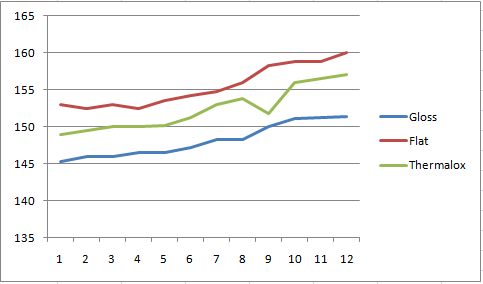 |
Sun at 45 degree azimuth test
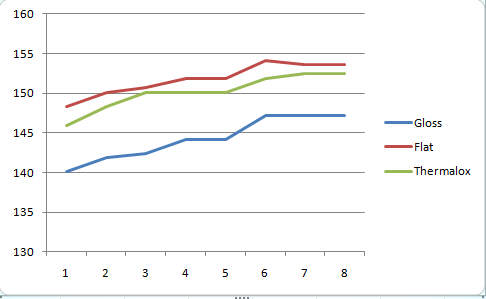 |
These pictures show the test
setup:
If you see anything that
looks wrong, please let me know.
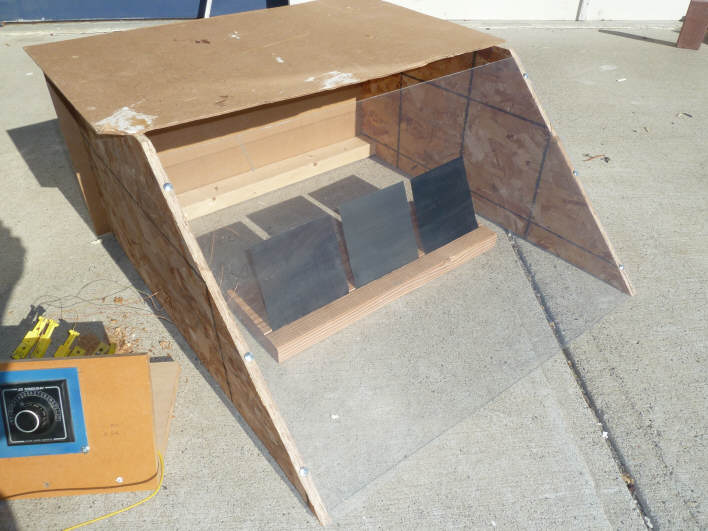
Samples from left to right
are Thurmalox, flat black spray paint, gloss enamel spray paint.
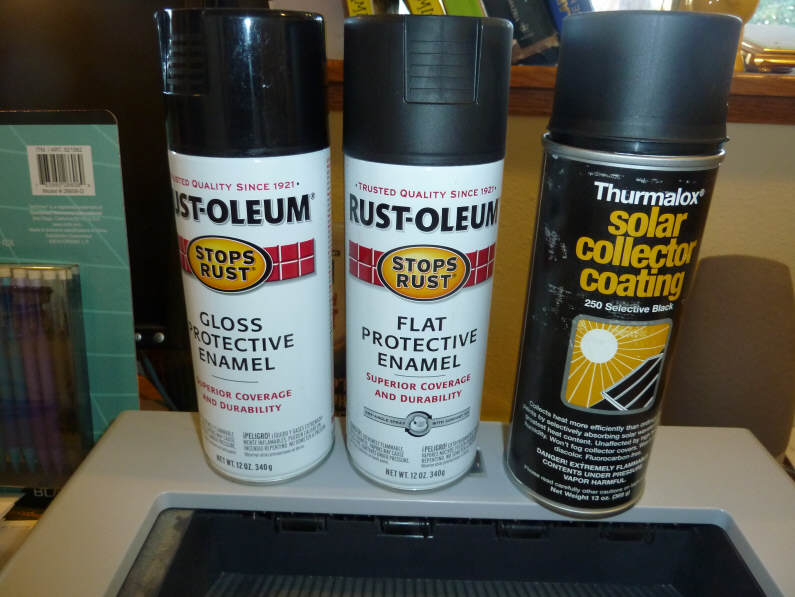
The three paints.
The cover is intentionally
leaky to allow a little air circulation, but to keep any light breezes away from
the samples.
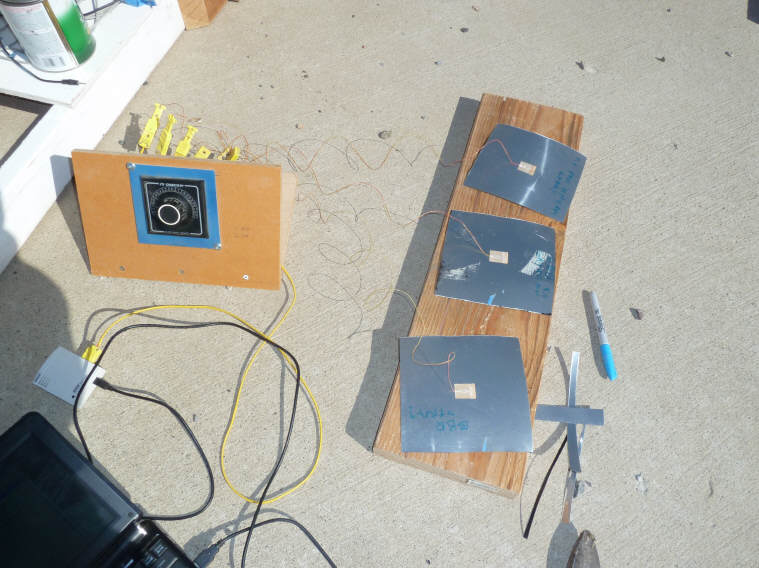
This picture from the previous day
test shows how the surface mount thermocouples are stuck to the back of the
samples.
The thermocouples come into the TC
switch at the left, and the temperature values are read by the Onset Computer
logger (little white) box, and then read on the little laptop. The switch
is needed because the logger only reads one thermochouple input at a time.
So, readings were taken by switching
to each thermocouple in succession -- cycling through all three takes about 10
seconds. The cycle was repeated about 10 times to insure consistency.
While the average temperatures drifted up a bit during the test, the differences
between flat and gloss were quite consistent.
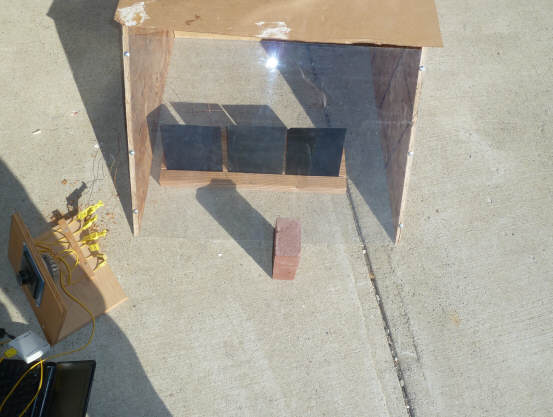
The samples and enclosure rotated to
produce an about 45 degree sun azimuth angle.
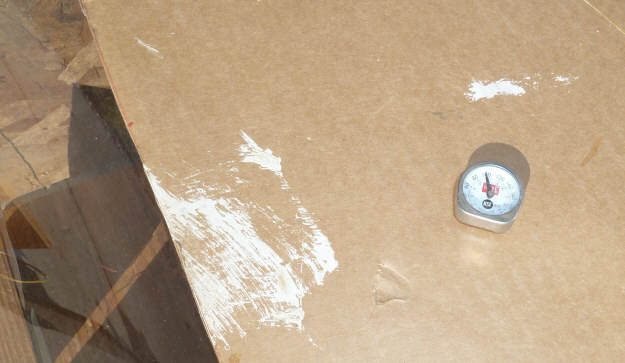
Air temperature inside the enclosure
was about 93F. Ambient temp started at 60 F and was rising during the test
period.
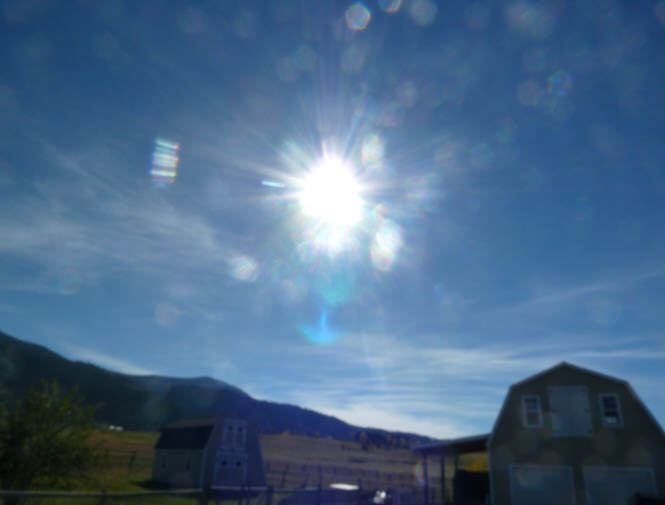
The sky was nearly clear with some
high, thin, wispy clouds.
The Test Spreadsheet Results
|
Comparison of absorber paints |
|
|
|
|
|
|
|
|
|
|
|
27-Sep-10 |
|
|
|
|
|
|
|
|
|
|
|
|
|
Gloss = Rust-Oleum Gloss Protective Enamel 7779 Gloss Black |
|
|
|
|
|
|
|
|
Flat = Rust-Oleum Flat Protective Enamel 7776 Flat Black |
|
|
|
|
|
|
|
|
Thurmalox = Thurmalox Solar Collector Coating 250 Selective Black |
|
|
|
|
|
|
| |
|
|
|
|
|
|
|
|
|
|
|
|
|
Weather was quite clear with some very thin lacey widely dispersed
clouds, Tamb 60F at start |
|
|
|
|
|
Air temperature in enclosure was 90F near end of test. |
|
|
|
|
|
|
|
| |
|
|
|
|
|
|
|
|
|
|
|
|
|
Near direct incidence test |
|
|
|
| |
Gloss |
Flat |
Thurmalox |
|
10:10 AM |
145.36 |
153 |
148.89 |
|
| |
145.95 |
152.4 |
149.47 |
|
| |
145.95 |
153 |
150 |
|
| |
146.54 |
152.4 |
150.06 |
|
| |
146.54 |
153.58 |
150.16 |
|
| |
147.13 |
154.17 |
151.24 |
|
| |
148.3 |
154.76 |
153 |
|
| |
148.3 |
155.93 |
153.8 |
|
| |
150.06 |
158.28 |
151.82 |
|
|
10:18 AM |
151.06 |
158.86 |
155.93 |
|
| |
151.24 |
158.86 |
156.52 |
|
| |
151.41 |
160.04 |
157.1 |
|
| |
|
|
|
|
|
45 degree azimuth test |
|
|
|
| |
Gloss |
Flat |
Thurmalox |
|
10:22 |
140.07 |
148.3 |
145.95 |
|
| |
141.84 |
150.06 |
148.3 |
|
| |
142.42 |
150.65 |
150.06 |
|
| |
144.19 |
151.82 |
150.06 |
|
| |
144.19 |
151.82 |
150.06 |
|
|
10:28 AM |
147.13 |
154.17 |
151.82 |
|
| |
147.13 |
153.58 |
152.41 |
|
| |
147.13 |
153.58 |
152.41 |
|
| |
|
|
|
|
| |
|
|
|
|
| |
|
|
|
|
| |
|
|
|
|
| |
|
|
|
|
Gary
September 27, 2010


